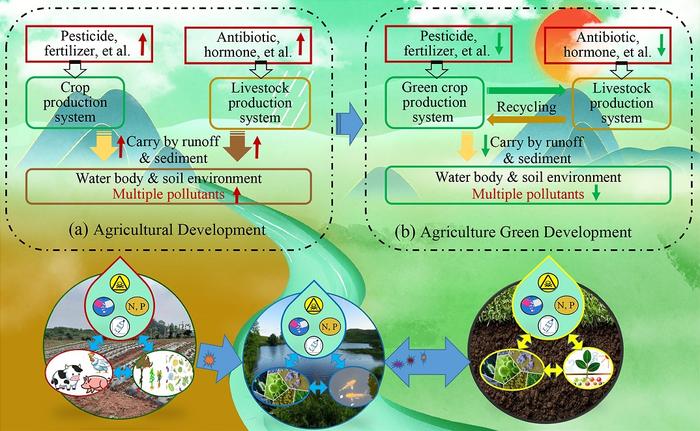The rapid increase in the proportion of cash crops and livestock production in the Yangtze River Basin (YRB) has led to commensurate increases in fertilizer and pesticide inputs. Excessive application of chemical fertilizer, organophosphorus pesticides and inappropriate disposal of agricultural waste induced water pollution and potentially threaten green agricultural development. To ensure food security and the food supply capacity of the Yangtze River Basin, it is important to balance green and development, while ensuring the quality of water bodies. Multiple pollutants affect the transfer, adsorption, photolysis and degradation of each other throughout the soil–plant–water system. Prof. Xinping Chen from Southwest University and his team considers the impact of multi-pollutants on the nitrogen and phosphorus cycles especially for crops, which are related to achieving food security and agricultural green development. It presents prospective on theory, modeling and multi-pollutant control in the YRB for Agriculture Green Development (AGD) that are of potential value for other developing regions.

Credit: Lihua MA , Shiyang LI , Linfa FANG , Xuanjing CHEN , Ran XIAO , Xiaoxuan SU , Zhaolei LI , Zhaohai BAI , Lin MA , Prakash LAKSHMANAN , Xinping CHEN
The rapid increase in the proportion of cash crops and livestock production in the Yangtze River Basin (YRB) has led to commensurate increases in fertilizer and pesticide inputs. Excessive application of chemical fertilizer, organophosphorus pesticides and inappropriate disposal of agricultural waste induced water pollution and potentially threaten green agricultural development. To ensure food security and the food supply capacity of the Yangtze River Basin, it is important to balance green and development, while ensuring the quality of water bodies. Multiple pollutants affect the transfer, adsorption, photolysis and degradation of each other throughout the soil–plant–water system. Prof. Xinping Chen from Southwest University and his team considers the impact of multi-pollutants on the nitrogen and phosphorus cycles especially for crops, which are related to achieving food security and agricultural green development. It presents prospective on theory, modeling and multi-pollutant control in the YRB for Agriculture Green Development (AGD) that are of potential value for other developing regions.
The structure of the cropping system has evolved to simultaneously meet the increasing demand for both human food and animal feed. Animal manure is effectively recycled for crop use, and these waste and pollution sources become the resources in crop production. However, the safe and sustainable use of organic fertilizers for crop production is yet to be fully implemented. In addition to nutrient pollutants, the YRB faces severe water quality issues caused by the combined effects of other pollutants, including antibiotics and pesticides. These distressing discoveries emphasize the need to raise awareness about the multiple pollutants in the YRB and urge the public to take necessary measures to address these issues.
The biological, physical and chemical interactions of multiple pollutants like antibiotics, pesticides and nutrients (N and P) and their biogeochemical cycles limit global and national efforts to achieve AGD. It is essential to consider the transport mechanism of coexisting pollutants via hydrological processes, especially in mountain areas with cash crops. In addition to the toxicity of each pollutant, the complex interactions between multiple pollutants need to be more thoroughly understood to assess and manage the ecological risks of water and soil pollution effectively. The water quality modeling approach is a tool to better understand the hotspots and sources of water quality issues and to provide evidence for policymaking and policy implementation for the provision of clean water. Ecological thresholds are useful indicators for identifying pollution levels, and it serves as restoration goals for aquatic and terrestrial systems enabling the formulation of future management options. However, the ecological thresholds for multiple pollutants, other than nutrients, have yet to be set by consensus.
Reducing mineral fertilizer applications in line with efficient nutrient utilization is the key to achieving the goals of green and sustainable agriculture. Soil microorganisms drive key functions in agroecosystems, determining soil fertility, crop productivity and stress tolerance. Multi-pollutant river models will formally represent nutrient cycling processes knowledge, allowing them to reason through previously unseen tasks and use agricultural or environment-accurate language to explain their outputs. Overall, this study reflect on future directions for multi-pollutant modeling and the linking model results to policymaking. Policymakers, scientists and other stakeholders have to work together with academics and technical experts for agricultural green development in the YRB. Analyses of dietary trends and food supply should guide local agricultural development, which will determine future multi-pollutant scenarios. Climate change effects, such as an extreme rainstorm, heat waves and drought events, require the policy design to ensure the crop and livestock production are more inclusive of extreme climate events in the YRB. It is hoped that recognition of these potential risks will improve the overall level of accounting for consequences associated with multiple pollutants from crop and livestock production under policy scenarios in the YRB.
This study has been published on the Journal of Frontiers of Agricultural Science and Engineering in Volume 11, Issue 1, 2024, DOI: 10.15302/J-FASE-2023511
Journal
Frontiers of Agricultural Science and Engineering
Method of Research
Experimental study
Subject of Research
Not applicable
Article Title
Multiple pollutants from crop and livestock production in the Yangtze River: status and challenges
Article Publication Date
8-Mar-2024



